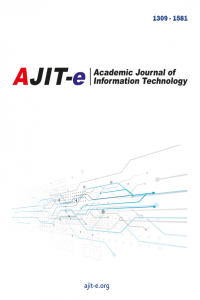Arnavutluk ve Kosova'daki Çevrim içi Gazetelerde Türkiye Hakkındaki Haberlerin Çerçevelendirilmesi: 2016 Darbe Girişimi ile İlgili Lake Memorial Örneği
Bu araştırma, Balkanlar'da, özellikle Arnavutluk ve Kosova'da Türkiye aleyhine çerçeveleme içerikli medya makalelerinde kullanılan dili incelemektedir. Osmanlı İmparatorluğu'nun dağılmasının ardından ortaya çıkan Arnavut ulusal kimliği ve milliyetçiliği, modern tarihin farklı evrelerinde zaman zaman alevlenmiştir. Bugün Türkiye ile ilişkilerde bu milli yaklaşımın sembollerinin, şiirsel unsurlarının ve retoriğinin izlerini silmek mümkündür. Bununla ilgili olarak bu çalışmada Arnavutluk'ta Türk-Arnavut halklarının dostluğunun simgesi olarak dikilen 15 Temmuz şehitleri anısına Tiran parkına Türk anıtı yapılmasına Arnavut medyasının milliyetçi bir bakış açısıyla nasıl yer verdiğine, devrim, milliyetçilik retoriğinin nasıl yeniden gündeme geldiğine odaklanmaktadır. Toplam 69 haber hem nicel hem de nitel yöntemlerle analiz edilmekte ve gazetecilerin haberlerinde milliyetçi bakış açısına ilişkin haber çerçeveleme kategorileri belirlenmiştir. Nitekim her iki ülke medyasının milliyet ile ilgili haberler yaptığı, ilgili olayın Arnavutluk ile yaşanmasına rağmen Kosova medyasının Arnavutluk medyasına göre daha fazla haber kullandığı tespit edilmiştir. Bu milliyetçi yaklaşım, Türkiye'nin Balkanlardaki Arnavut ulusu için jeostratejik, siyasi ve kültürel bir tehdit olarak algılanmaya devam ettiği şeklinde görülebilir.
Anahtar Kelimeler:
Arnavutluk, Kosova, Türkiye, Milliyetçilik, Haber Çerçeveleme
Framing News About Turkey in Albanian and Kosovo Online Newspapers: The Case of Lake Memorial About 2016 Coup Attempt in Turkey
This research examines the language used in media articles with framing content against Turkey in the Balkans, specifically in Albania and Kosovo. Albanian national identity and the nationalism that arose following the breakup of the Ottoman Empire have periodically resurfaced throughout modern history. Today, Albanian nationalism can sever ties with modern Turkey, often portraying the past and present in a negative light. The study focuses on how Albanian media with a nationalist perspective covered the construction of a Turkish memorial in Tirana's park, which was intended as a symbol of friendship between the two countries and as a tribute to the martyrs of July 15th. A total of 69 news articles were analyzed using both quantitative and qualitative methods, and categories of news framing related to a nationalist perspective in the journalists' reporting were identified. The results showed that media outlets in both countries covered the event, but Kosovo media displayed a higher level of framing against Turkey, despite the fact that the event took place in Albania. This nationalist approach suggests that Turkey continues to be perceived as a geostrategic, political, and cultural threat to the Albanian nation in the Balkans.
Keywords:
Albania, Kosovo, Turkey, Nationalism, News Framing.,
___
- Althusser, L. (2010). Ideology and Ideological State Apparatuses (Notes towards an Investigation). Cultural theory: an Anthology.
- Aygen, M (2018). Türkiye ve Darbeler: 15 Temmuz Örneği. Fırat Üniversitesi Sosyal Bilimler Dergisi, 28 (2), 231-253.
- Becker, Lee B. & McCombs, M. (1978). The Role of The Press in Determining Voter Reactions to Presidential Primaries1. Human Communication Research, 4(4), 301-307.
- Carroll, C. E. & Mccombs, M. (2003). Agenda-Setting Effects of Business News on the Public's Images and Opinions About Major Corporations. Corporate Reputation Review.
- Chyi, H. I. & Mccombs, M. (2004). Media Salience and the Process of Framing: Coverage of the Columbine School Shootings. Journalism & Mass Communication Quarterly.
- Clayer, N. (2015). Albania. The Wiley Blackwell Encyclopedia of Race, Ethnicity, and Nationalism.
- CNN Türk, https://www.cnnturk.com/turkiye/15-temmuz-darbe-girisiminin-bilancosu, (14.01.2021).
- De Vreese, C. H., Boomgaarden, H. G. & Semetko, H. A. (2011). (In) Direct Framing Effects: The Effects of News Media Framing on Public Support for Turkish Membership in the European Union. Communication Research, 38 (2), 179-205.
- Druckman, J. N. (2001). The Implications of Framing Effects for Citizen Competence. Political Behavior, 23 (3), 225-256.
- Duijzings, G. (2000). Religion and the Politics of Identity in Kosovo. Columbia University Press.
- Fischer, B. J. (2005). A Brief Historical Overview of the Development of Albanian Nationalism Bernd. Animal Behaviour.
- Gamson, W. A., & Modigliani, A. (1989). Media Discourse and Public Opinion on Nuclear Power: A Constructionist Approach. American Journal of Sociology.
- Haider‐Markel, D. P. & Joslyn, M.R. (2001). Gun Policy, Opinion, Tragedy, and Blame Attribution: The Conditional Influence of Issue Frames. Journal of Politics, 63 (2), 520-543.
- Hoxha, H. (2007). Barrierat E DialogutDheShkaqet E DështimitTëTijNëKohënBashkëkohore.
- https://www.sozcu.com.tr/2020/gundem/bakan-soylu-feto-bilancosunu-acikladi-99-bin-066-operasyon-5931900/
- Iyengar, S. & Kinder, D.R. (2010). News That Matters: Television and American Opinion. University of Chicago Press.
- Iyengar, S. (1994). Is Anyone Responsible?: How Television Frames Political Issues. University of Chicago Press.
- Mccombs, M. (1997). Building Consensus: The News Media's Agenda-Setting Roles. Political Communication.
- Mccombs, M. E. & Shaw, D.L. (1972). The Agenda-Setting Function of Mass Media. Public Opinion Quarterly.
- Neuman, W. R., Just M. R. & Crigler, A.N. (1992). Common Knowledge: News and the Construction of Political Meaning. University of Chicago Press.
- Psilos, C. (2006). Albanian Nationalism and Unionist Ottomanization 1908 to 1912. Mediterranean Quarterly.
- Rrapaj, J.& Kolasi, K. (2013). The Curious Case of Albanian Nationalism: the Crooked Line from a Scattered Array of Clans to a Nation-State. The Turkish Yearbook of International Relations, 44, 185-228.
- Scheufele, D. (1999). Framing as a Theory of Media Effects. Journal of Communication.
- Severin, W. J. & Tankard, J.W. (1997). Communication theories: Origins, methods, and uses in the mass media. Longman.
- Sugar, Peter F (Ed.). (1995). Eastern European Nationalism in the Twentieth Century. American University Press.
- Sulstarova, E. (2006). Arratisje Nga Lindja: Orientalizmi Shqiptar Nga Naimi te Kadareja. Globic Press.
- Sulstarova, E. (2012). Rilindja’s Place in the Orientalism of Intellectuals in Post-Communist Albania. Annales, 391-400.
- Tuncer, F.F. (2012). Kosova’daTarihYazimiTartişmalari: Osmanli ve Türk İmaji. Balkan Araştırmaları Dergisi, 3(2), 69-96.
- Xhaferi, P. (2021). The post-ottoman era: A fresh start for bilateral relations between albania and turkey? Australian and New Zealand Journal of European Studies, 9(1). https://doi.org/10.30722/anzjes.vol9.iss1.15173
- Yayın Aralığı: Yılda 4 Sayı
- Başlangıç: 2010
- Yayıncı: Akademik Bilişim Araştırmaları Derneği
